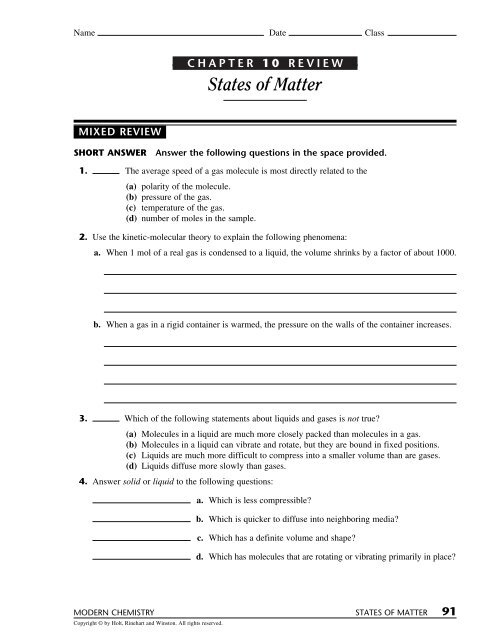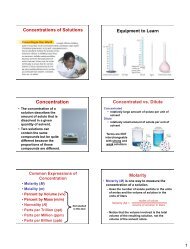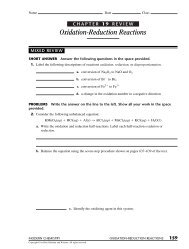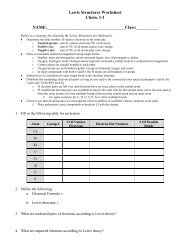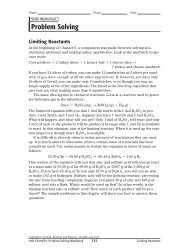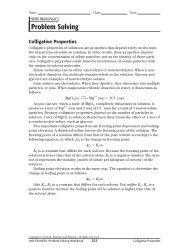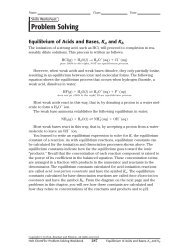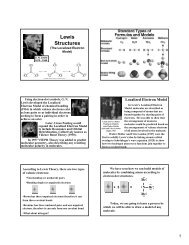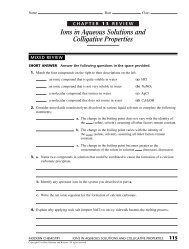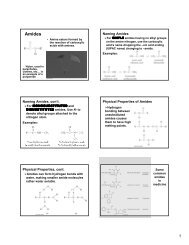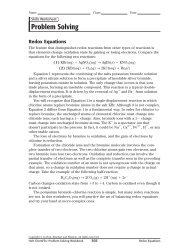Ch. 10 Review
Ch. 10 Review
Ch. 10 Review
Create successful ePaper yourself
Turn your PDF publications into a flip-book with our unique Google optimized e-Paper software.
Name Date ClassCHAPTER <strong>10</strong> REVIEWStates of MatterMIXED REVIEWSHORT ANSWERAnswer the following questions in the space provided.1. The average speed of a gas molecule is most directly related to the(a) polarity of the molecule.(b) pressure of the gas.(c) temperature of the gas.(d) number of moles in the sample.2. Use the kinetic-molecular theory to explain the following phenomena:a. When 1 mol of a real gas is condensed to a liquid, the volume shrinks by a factor of about <strong>10</strong>00.b. When a gas in a rigid container is warmed, the pressure on the walls of the container increases.3. Which of the following statements about liquids and gases is not true?(a) Molecules in a liquid are much more closely packed than molecules in a gas.(b) Molecules in a liquid can vibrate and rotate, but they are bound in fixed positions.(c) Liquids are much more difficult to compress into a smaller volume than are gases.(d) Liquids diffuse more slowly than gases.4. Answer solid or liquid to the following questions:a. Which is less compressible?b. Which is quicker to diffuse into neighboring media?c. Which has a definite volume and shape?d. Which has molecules that are rotating or vibrating primarily in place?MODERN CHEMISTRY STATES OF MATTER 91Copyright © by Holt, Rinehart and Winston. All rights reserved.
Name Date ClassMIXED REVIEW continued5. Explain why almost all solids are denser than their liquid states by describing what is occurring atthe molecular level.6. A general equilibrium equation for boiling isliquid energy ← → vaporIndicate whether the forward or reverse reaction is favored in each of the following cases:a. The temperature of the system is increased.b. More molecules of the vapor are added to the system.c. The pressure on the system is increased.7. Freon-11, CCl 3 F has been commonly used in air conditioners. It has a molarmass of 137.35 g/mol and its enthalpy of vaporization is 24.8 kJ/mol at itsnormal boiling point of 24°C. Ideally how much energy in the form of heatis removed from a room by an air conditioner that evaporates 1.00 kg offreon-11?8. Use the data table below to answer the following:EnthalpyMolar mass vaporization Normal boiling CriticalComposition (g/mol) (kJ/mol) point (°C) temperature (°C)He 4 0.08 269 268Ne 20 1.8 246 229Ar 40 6.5 186 122Xe 131 12.6 <strong>10</strong>7 17H 2 O 18 40.8 <strong>10</strong>0 374HF 20 25.2 20 188CH 4 16 8.9 161 82C 2 H 6 30 15.7 89 32a. Among nonpolar liquids, those with higher molar masses tend tohave normal boiling points that are (higher, lower, or about the same).b. Among compounds of approximately the same molar mass, thosewith greater polarities tend to have enthalpies of vaporization thatare (higher, lower, or about the same).c. Which is the only noble gas listed that is stable as a liquid at 0°C? Explain your answer usingthe concept of critical temperature.92 STATES OF MATTER MODERN CHEMISTRYCopyright © by Holt, Rinehart and Winston. All rights reserved.


